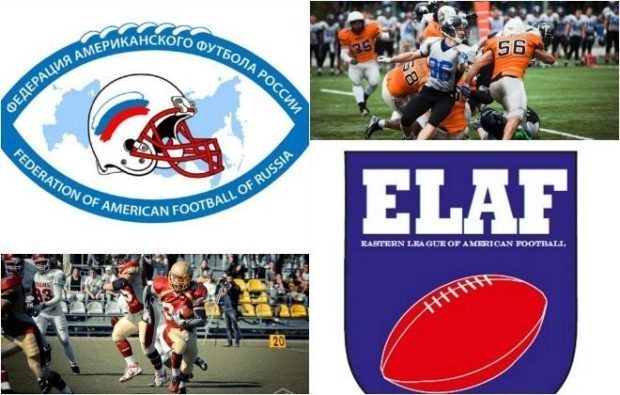The growth and development of American football throughout the world is not without its inherent problems and politics. At times, it is impossible to distinguish between steps that hurt or help the game. But regardless of how these conflicts are resolved, at the end of the day it is always encouraging to see teams getting over them and concentrating on athletic – not political – battles. AFI’s Ilya Kravtsov explains in this article.
The Eastern League of American Football (ELAF) was originally conceived as a cross-border competition in Eastern Europe. It experienced its ups and downs before reaching what seemed to be its final demise by the end of 2015. But nothing is ever as simple as it appears, and one needs to take a closer look at the history of this competition before reaching any kind of conclusion.
Originally, the ELAF was conceived by the teams from Russia and Belarus who disagreed with the policies of their respective federations (Federation of American Football of Russia – FAFR, and Belarus Federation of American Football – BFAF, respectively) and who wanted to create an alternative. The young Moscow Bruins and Minsk Litwins were at the forefront of this idea, but their message was soon heard by some other teams as well. Eventually, the 2012 season saw five teams abandoning the competitions organized by their official federation and participated in the ELAF tournament, which the Bruins won after defeating Litwins in the Final, 30-25.
Having seen that this competition was a viable alternative indeed, plenty others joined next season – with the league gaining a representative from the Ukraine in the Kiev Knights, as well as arguably the oldest surviving franchise in ex-Soviet Union – the Minsk Zubrs – ,who date their history all the way to the late 1980s. The latter won the tournament that year, finishing with a perfect season.
ELAF at its height in 2013
ELAF loses teams
In 2014, the league appeared to be in a decline of sorts, as with the quantitative growth of the official national competitions, many teams figured that they would have a better chance there. Furthermore, the reorganization of the national competitive structure in Russia, instigated under the leadership of the new head of Competition Committee of the FAFR, Artyom Polyakov, in 2015, had seen both supporters and opponents among the teams, as the Moscow Spartans and the Podolsk Knights left the ELAF for the FAFR, while the latter had lost Voronezh Mighty Ducks to the competing tournament. It has also established the ELAF Baltics division, as a sort of second-tier tournament.
However, it was that year when it came to the final showdown between the sides, and the catalyst for this struggle was the IFAF Europe Championship qualification stage. First, the Mighty Ducks canceled their season citing financial concerns. Then, the Zubrs announced that they were quitting the competition amidst the conflict over the uniform color during their game in Moscow against the Bruins. That left the ELAF with only two teams (the Bruins and the Litwins) ready to compete before the second leg of the tournament even started.
Russian federation flexes muscles
It was at that stage that the FAFR has announced that only the players participating in the tournaments officially sanctioned by an IFAF-member federation were eligible to participate in the Russian national team, which the Bruins players were not. The Bruins announced they were joining the FAFR immediately and agreed to hold one final game against the Litwins en lieu of the rest of the season in ELAF to decide the 2015 champion. However, even that was not enough as the FAFR forced them to abandon that game as well – and the Litwins automatically got the nominal title as the only team left in the league.
The classic ELAF rivalry between the Litwins and the Bruins
Critics have called it blackmailing on the part of the FAFR saying that it is using its IFAF-membership as unfair leverage. However, proponents have argued that it was necessary to bring all the teams in the region under a single competitive framework to further develop the game that was already marred with logistical issues related to the huge geographical area covered by both tournaments. It was also ironic that in the end, none of the Moscow Bruins made the final national team roster (when Russia beat Norway 20-0 in their Group-B qualifier), and it all appeared for naught – except for the fact one of the founding teams of the ELAF now appears to be set to finally join the FAFR Russian Championship in 2016.
Belarus makes surprise move
And it didn’t end there either! Seeking quality tournaments to participate in themselves, both the Minsk Zubrs and the Litwins were officially invited to participate in the Russian Championship in 2016 and appear to be headed in that direction as well. It looked like the FAFR had finally won, and the ELAF appeared to be history, until Belarus Federation of American Football decided to revive the idea – but on the amicable terms with all the neighboring federations.
The Belarus Federation, who had played a nominal role in the conflict throughout these years (as they lacked enough quality teams to field a national championship of their own), has announced that it is taking the ELAF concept over this upcoming season. Based on the young teams from the region of Belarus and the Baltics that took part in the ELAF Baltica division in 2015, the BFAF is organizing an open-to-all ELAF-2016 tournament under its own umbrella. And with the BFAF being an official IFAF-member, the ELAF has thus gained an “official” status of its own, although at the cost of its oldest and best teams.
But whatever the ELAF is going to look like down the road, it doesn’t appear to be at odds with any other regional federation any longer. And here’s hoping that there will now be one conflict less in the messy world of international American football.

